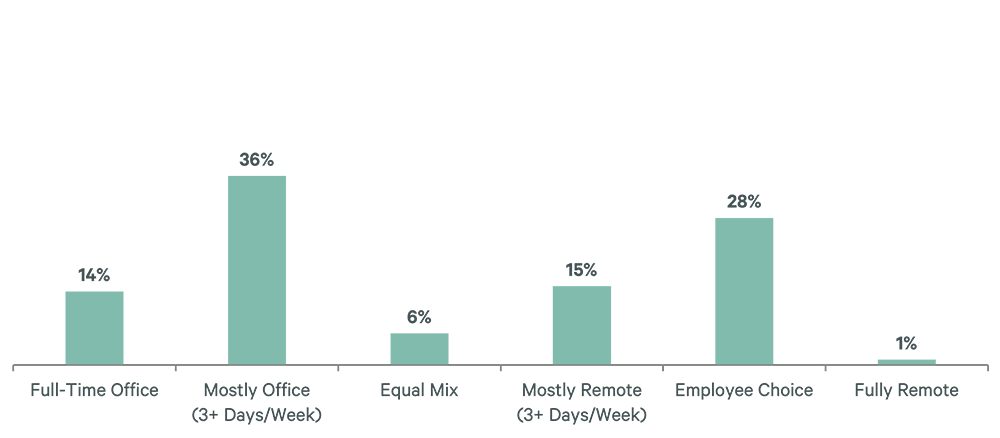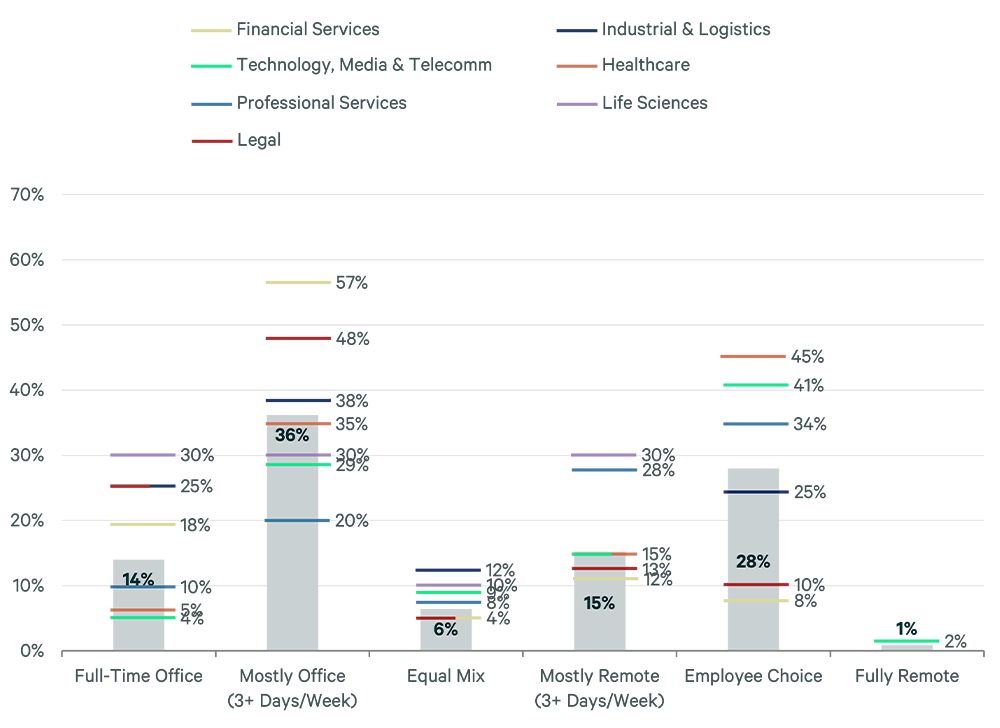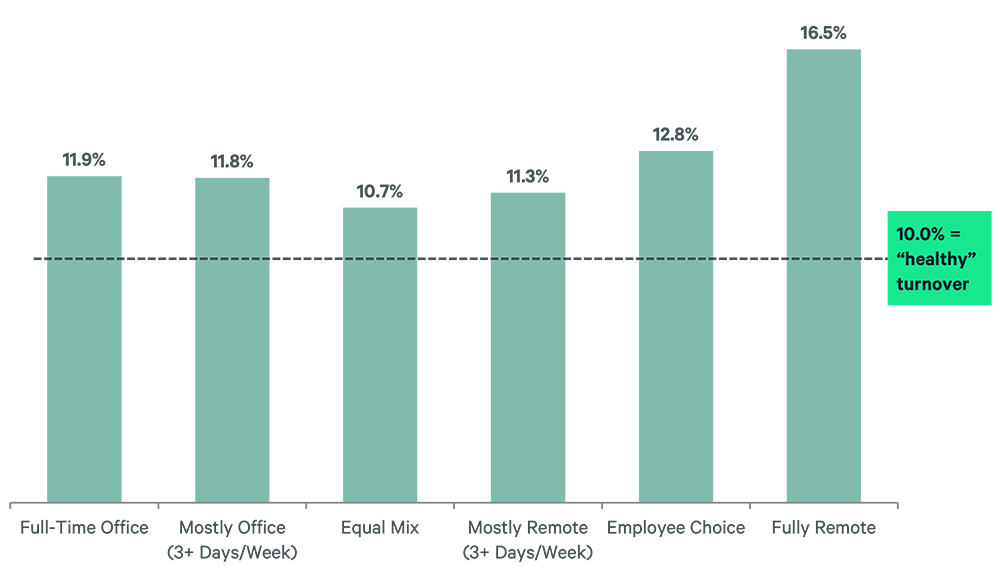Evolving Workforces
U.S. Office Attendance Policies Midyear 2024
Latest Findings Indicate Stabilized Hybrid Office Attendance Expectations
July 1, 2024 5 Minute Read

Introduction
CBRE Americas Consulting started tracking office policies for over 340 U.S. companies beginning in January 2023 to better understand the emerging consensus on office show-up expectations and to uncover any directional shifts in stated policies.
In March 2020, a pandemic-induced transition to fully remote work happened overnight. Now, four years later, companies are implementing a wide range of office-use expectations and policies.
Observed Office Attendance Policies
Figure 1: What is the current published office attendance policy?

N= 343 companies sourced through CBRE client data and publicly available statements to the press/announcements on company websites.
Key Takeaway #1
Organizations are now expecting people to work at the office from two to four days per week. Even organizations that do not require employees to work in the office have maintained a real estate footprint.
- 99% of organizations in the sample have office space available to support their business and employees.
- 71% of organizations in the sample have a policy that includes some expectation for in-office employee attendance.
- 14% of organizations in the sample have fully in-office policies requiring five days per week in the office.
- 58% of organizations in the sample have a hybrid or flexible attendance policy.
- 36% of these were “mostly office” requiring three or more days of office attendance per week.
- 6% of companies were an equal mix of office and remote work.
- 15% were “mostly remote” requiring two or fewer days of office attendance per week.
- 28% of organizations in the sample were “employee choice”—these companies have office space available but no requirements for employees to use the office in any frequency.
- 1% of organizations in the sample are “fully remote” with no physical space.
Figure 2: How does attendance policy vary by industry sector?

N= 343 companies sourced through CBRE client data and publicly available statements to the press/announcements on company websites.
Key Takeaway #2
Variations exist in attendance policy based on a company’s industry. Those with greater equipment dependencies tend to require more days of in-office work.
- Technology and professional services companies are most likely to have remote-centric attendance policies while companies in financial services, life sciences and legal exhibit more office-centric policies.
- Industries that are equipment-dependent typically have policies for in-office work: 60% of life sciences companies and 63% of industrial & logistics companies have either fully or mostly in-office attendance policies.
- Three-quarters of financial services (75%) and law firms (76%) have either fully or mostly in-office attendance policies.
- 40% of tech companies and 45% of healthcare (includes corporate office policy only) companies have employee choice policies versus 28% of all companies in the data set.
Potential Impacts on Talent Retention
While many internal and external factors impact a company’s ability to attract and retain talent, the CBRE Americas Consulting team investigated the potential relationship between a company’s stated attendance policy and trends in turnover rates. The turnover rates for full in-office and those with hybrid attendance policies, on average, are only slightly above what’s deemed to be a “healthy” organizational turnover rate at 10.0%. Companies with employee choice and the small number of fully remote companies (with no option for in-office attendance) have average turnover rates that are higher than the other more office-leaning attendance policies.
Figure 3: Does employee turnover risk vary by attendance policy?

Key Takeaway #3
Companies with full-time office or hybrid policies have the lowest average turnover rates.
- Generally, a “healthy” organization turnover rate is at or near 10% annually.
- Companies with an “equal mix” attendance policy have the lowest average turnover rates, at 10.7%.
- Full-time office companies have an average turnover of 11.9%, while those with a “mostly office” policy averaged 11.8%.
- Employee-choice companies—those that do not require in-office attendance but maintain a physical office footprint with the option for in-office work—have slightly elevated turnover, averaging 12.8%.
- The highest turnover rates are among the smaller set of fully remote companies with no in-office attendance option—these companies averaged 16.5%.
Policy Implementation
Hybrid companies are using a variety of guidelines to implement their policy, such as required in-office days, teams/managers deciding the days and employee choice.
Of the 58% of organizations that required 1 to 4 days in the office per week, 81% have a set expectation on required frequency (e.g. 3 days per week) versus 19% that have designated organization-wide days required (e.g. Tuesday and Thursday).
In a focus group conducted with more than 50 CBRE clients, few reported enforcing compliance with office show-up policies. However, 78% indicated that they have started to track adherence to office policy and utilization through badge show-up data or on-site manager reporting.
The variety of strategies companies are using to implement their office policies illustrates the importance of articulating the value of the office to the organization and providing the training and workplace experience investments to support that vision.
Related Services
- Transform Business Outcomes
Consulting
Gain comprehensive guidance on insightful, executable real estate strategies for both investors and occupiers.
- Consulting
Labor Analytics
Make better location decisions with a holistic approach that weighs factors like labor costs and availability, supply chain logistics, and incentives.
Build resilience, attract and retain talent, and foster connection and collaboration in your workplace.
Related Insights
-
Local Response | Creating Resilience
Workplace & Occupancy Management Technology in 2024
April 29, 2024

This report focuses on global workplace technology data derived from CBRE clients representing 350 million sq. ft./32 million sq. m. and provides insights by portfolio size and geography.
-
Local Response | Future Cities
Headquarters Relocation Is an Opportunity to Reshape Employee Behaviors
April 1, 2024

A company’s decision to relocate its headquarters, whether locally or nationally, goes beyond just changing its physical location.


